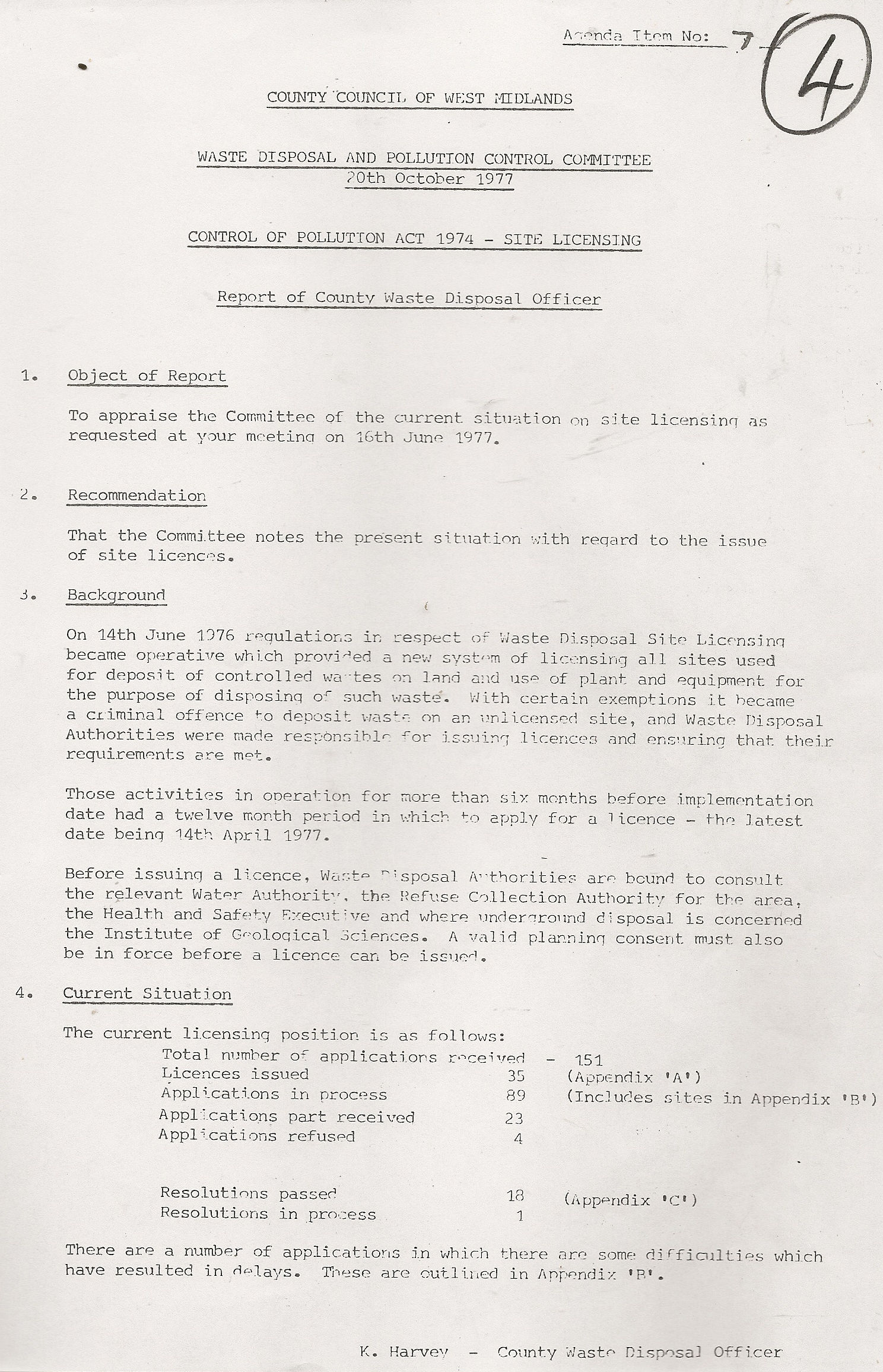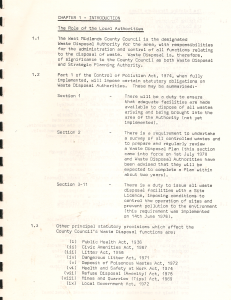LICENCE SL31 AND ITS LEGISLATIVE CONTEXT
The problems caused by hazardous waste and the methods by which it was being disposed of , particularly in the industrial West Midlands, was highlighted in the article below from The Birmingham Daily post of 31st May 1971. A chief public health inspector from Coventry outlined how waste disposal companies were looking for old clay pits and quarries to dump all manner of materials into, and the unsuitability of such places was creating “a pollution time bomb” legacy.
THE DEPOSIT OF POISONOUS WASTE ACT 1972
This was the first UK legislation to control waste management. The Deposit of Poisonous Waste Act was passed in 1972 and introduced the concept of a notification system to control the movement of waste.
It was introduced following the public outcry after some drums of cyanide waste were dumped at an abandoned brick kiln near Nuneaton and ensuing press coverage of waste disposal drivers taking bribes to dump hazardous waste illegally. The Act was drafted in 10 days and passed through Parliament within a month.
The Act made it an offence, for the first time, to deposit or abandon, poisonous, noxious or polluting waste on land in a way that could result in danger to public health or pollution of the Environment. Scares concerning dumped waste barrels became more common in the local press, particularly around industrially polluted areas such as Oldbury.

What solution did Albright and Wilson’s neighbours I.C.I find for disposing of their toxic waste barrels?
Notably, the surrounding area to Rattlechain lagoon was highlighted in the new legislation in terms of one of the first prosecutions being brought against waste dumpers on the adjoining landfill site. Some 250, 000 gallons of liquid and sulphuric acid waste was dispensed on the Rose Lane site allocated for cheap council housing. A number of waste disposal firms operating in the Bilston area were responsible. Though site investigations were carried out at the behest of West Midlands County council to trace whether the pollution posed a threat, they turned up very little- indicating that the location of testing may not have even been an accurate assessment of the exact area where the waste had been dumped. WHAT THIS NOW MEANS FOR THOSE RESIDENTS WHO NOW LIVE IN THE TEMPLE WAY ESTATE IS UNCLEAR.
The following letter suggests that “organic material” was being deposited into the lagoon before this Act. Unfortunately it appears that once again regulators were relying on the honesty of Albright and Wilson to provide them with lists and substances of materials deposited in the lagoon- in a nutshell this shows why this Act was a total and utter failure to control pollution and poisonous substances continuing to be dumped and deposited into the environment.
THE CONTROL OF POLLUTION ACT 1974
The previous Act, was repealed by The Control of Pollution Act 1974. On 14th June 1976 regulations in respect of Waste disposal site licensing became operative which provided a new system of licensing all sites used for deposit of controlled wastes on land and use of plant and equipment for the purpose of disposing of such waste. With certain exemptions, it became a criminal offence to deposit waste on an unlicenced site, and waste disposal Authorities were made responsible for issuing site licences and ensuring that their requirements were met.
Activities taking place for more than six months before implementation date had a twelve month period in which to apply for a licence- the latest being 14th April 1977.
Before issuing a license, Waste disposal Authorities were bound to consult the relevant Water Authority, the refuse Collection Authority for the area, The Health and Safety Executive, and where underground disposal was concerned The Institute of Geological Sciences. A valid planning consent was also needed before a site licence could be issued.
This information was contained in the minutes of The West Midlands County Council Waste Disposal and Pollution Control Committee meeting of October 20th 1977. It was revealed at this meeting that 151 applications had been received at this stage with 35 issued. At this stage , the Rattlechain licence was still to be passed, but it is noted that the Gower Tip licence , SL32 had resulted in difficulties given a contentious issue of allowing the tipping of phosphorus pentasulphide to continue.
The full licence conditions, still in force even though Rhodia are now no longer able to dispose of waste into Rattlechain, are detailed below.
The licence was issued on 23rd January 1978. An application for certificate of established use was applied for by Albright and Wilson prior to this, to fulfil the “planning consent” aspect.
Waste disposal licences were the responsibility of West Midlands County Council- an amalgamation of the seven local boroughs. Most site licences didn’t get issued until 1978. The original SL31 licence comprised of 30 conditions (1 condition of the draft being withdrawn), within summarised criteria relating to
- Types and quantities of waste- conditions 1-3
- Hours of operation- condition 4
- Control- conditions 5-7
- Disposal of wastes and operation of lagoons- conditions 8-15
- Roads and site security- conditions 16-22
- Other conditions- conditions 23-30
In 1980, a survey report on behalf of The WMCC outlined the role that they had in respect to different sections of the ACT.
It also described the different types of waste as defined by the legislation. The waste at Rattlechain was “industrial waste”.
When the West Midlands County Council was abolished in 1986, a Hazardous Waste Unit was set up to deal with sites such as this on a shared basis for the seven West Midland boroughs including Sandwell Council. This was based in Walsall to discharge these duties on their behalf. On 29th November 1991 Sandwell Council issued a modification notice adding a condition to the licence.
“31. From the 1st December 1991 a “Hazardous Waste Area” notice of the form specified below, shall be permanently fixed so that it is readily visible to anyone entering the site through the main entrance. It shall be in the colours shown and 600mm x 450mm in size and shall be made from a durable materials with a weather resistant finish. The notice shall also contain the disposal licence number and a telephone number through which a responsible person may be contacted in the event of an emergency occurring when the site is unattended.”
Conditions 32 and 33 also added by the council related to any change of the technically competent management staff in control of the Rattlechain and also having to inform them as the then waste regulatory authority if anyone from the company or persons named on the list had committed a relevant offence. This took effect from 6th February 1996.
ENVIRONMENTAL PROTECTION ACT 1990
Authorisation and enforcement was originally in the hands of HM Inspectorate of Pollution and local authorities but, as of 1996, became the responsibility of the Environment Agency and Scottish Environment Protection Agency (SEPA). Operation of a prescribed process is prohibited without approval and there are criminal sanctions against offenders.
Part II sets out a regime for regulating and licensing the acceptable disposal of controlled waste on land. Controlled waste is any household, industrial and commercial waste (s.75(4)). Unauthorised or harmful depositing, treatment or disposal of controlled waste is prohibited with prohibition enforced by criminal sanctions.
Part IIA – Contaminated land
Contaminated land is “any land which appears to the local authority in whose area it is situated to be in such a condition, by reason of substances in, on or under the land, that” (s.78A):
- “Significant harm is being caused or there is a significant possibility of such harm being caused; or
- Significant pollution of the water environment is being caused or there is a significant possibility of such pollution being caused.”
The Act does not apply to contamination from radioactivity (s.78YC) but similar provisions have been made under subsequent regulations.
Local authorities have a duty periodically to survey their locality and, using guidance defined by the Secretary of State, to designate contaminated land as a special site, advising the EA or SEPA (ss.78B-78C). The authority, EA or SEPA must then serve a remediation notice on the appropriate person (s.78E).
In 1996 the Environment Agency was created to take over from Hazardous Waste Units. The Agency have responsibility for monitoring and inspecting the site to see if the company are being compliant with the licence. Site “monitoring” was usually recorded on a Waste Management Licensing Site Inspection Report, though the name of this form has since changed. These reports offer a criteria of checks relevant to the site license and the waste disposal activities.
Since this period no other conditions have been added by the Environment Agency, nor any of the 33 conditions repealed or modified, though as waste tipping has now ceased, some are therefore now non-applicable.







